Green Engineering Solution Applicability in International Construction
VerifiedAdded on 2023/06/04
|18
|6815
|126
Report
AI Summary
This report investigates the applicability of green engineering solutions within the context of international construction, addressing the growing environmental concerns associated with the industry. It delves into the significance of green building practices, highlighting the reduction of carbon emissions, water usage, and waste output. The report explores the concept of green engineering, emphasizing its role in minimizing pollution and promoting sustainability through waste reduction, material management, pollution prevention, and product enhancement. It examines the environmental impacts of construction in developing countries, considering factors like resource depletion and pollution, while also discussing the contributions of green engineering approaches in mitigating these effects. The report also touches upon the benefits of adopting green engineering principles, including health advantages, improved environmental quality, and cost reductions, ultimately aiming to provide a comprehensive overview of sustainable construction practices in an international context.
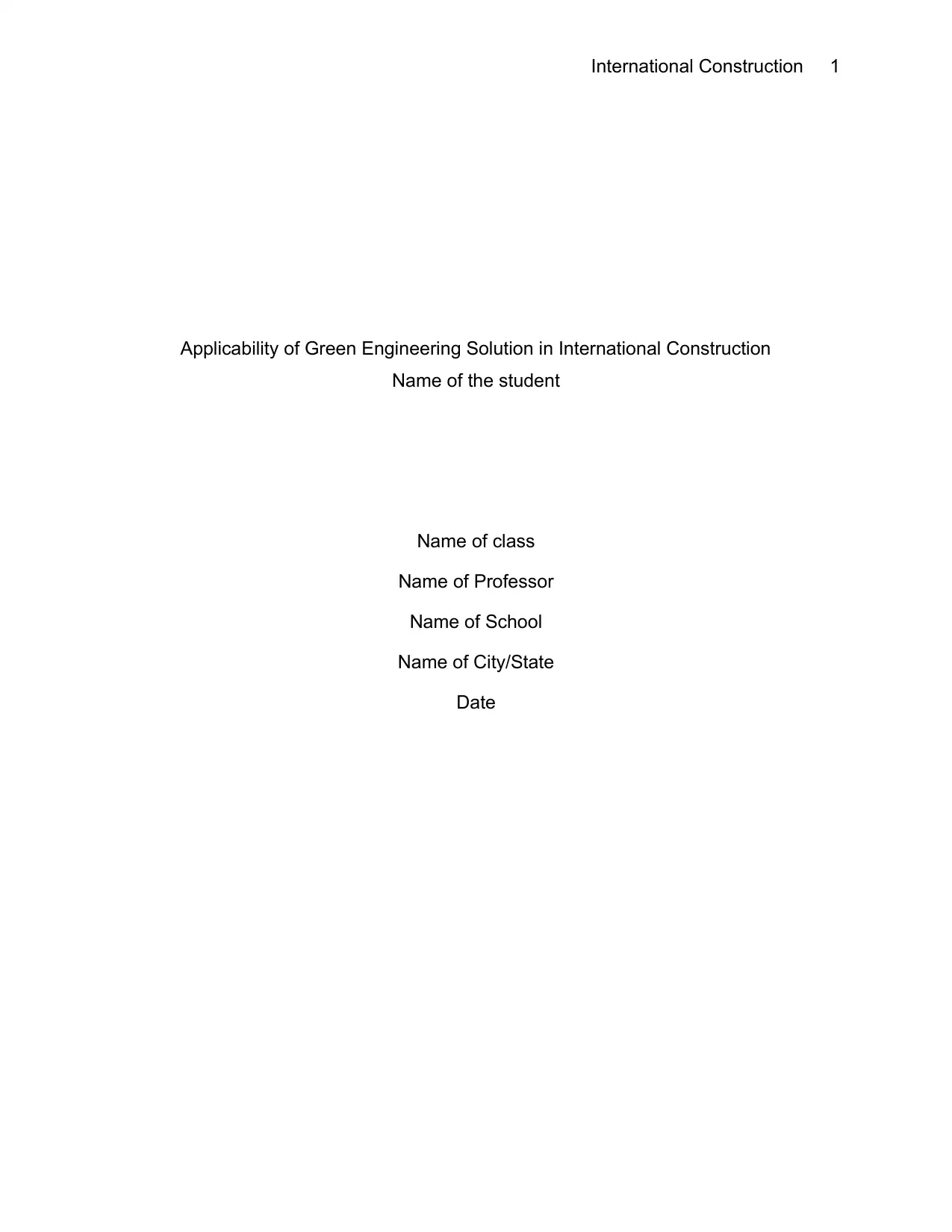
International Construction 1
Applicability of Green Engineering Solution in International Construction
Name of the student
Name of class
Name of Professor
Name of School
Name of City/State
Date
Applicability of Green Engineering Solution in International Construction
Name of the student
Name of class
Name of Professor
Name of School
Name of City/State
Date
Paraphrase This Document
Need a fresh take? Get an instant paraphrase of this document with our AI Paraphraser
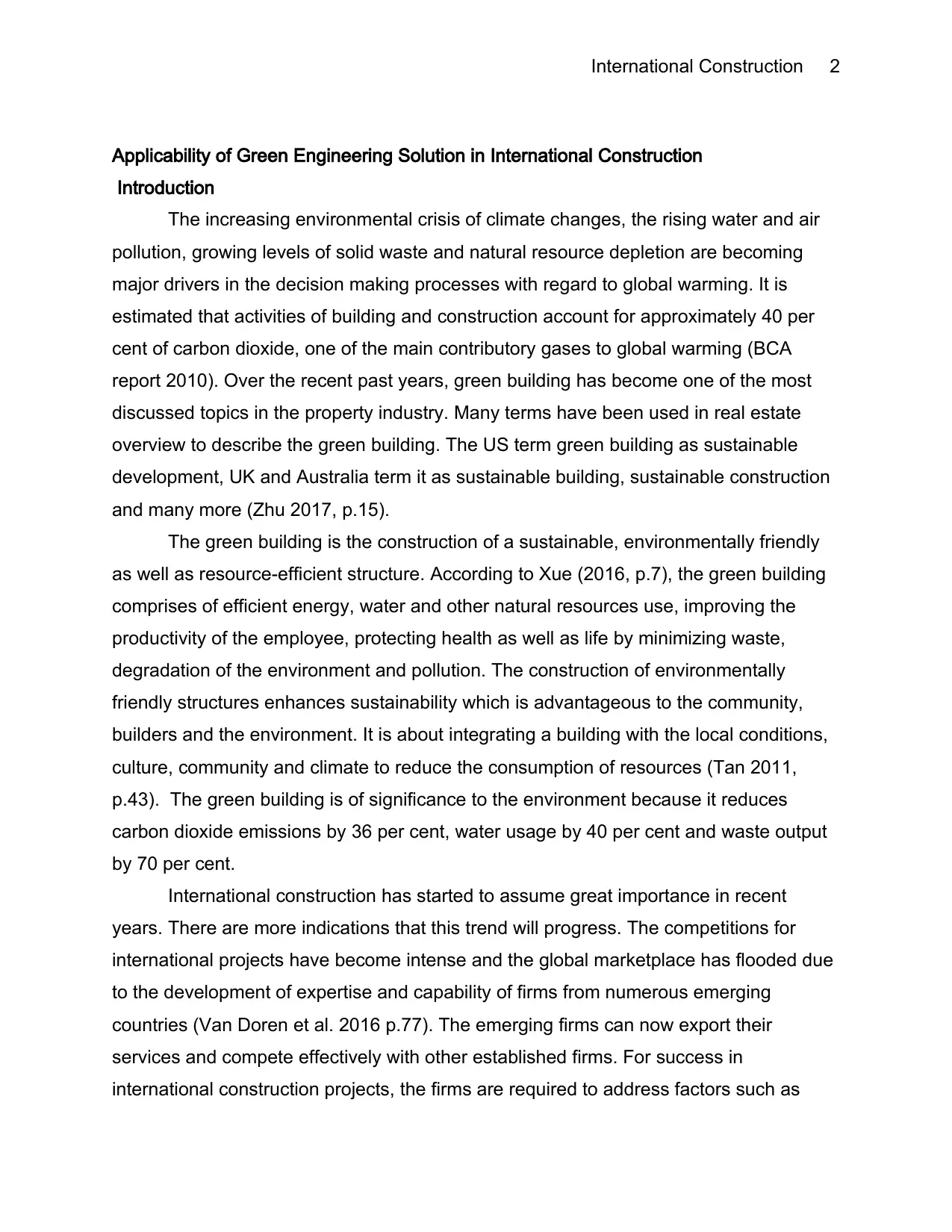
International Construction 2
Applicability of Green Engineering Solution in International Construction
Introduction
The increasing environmental crisis of climate changes, the rising water and air
pollution, growing levels of solid waste and natural resource depletion are becoming
major drivers in the decision making processes with regard to global warming. It is
estimated that activities of building and construction account for approximately 40 per
cent of carbon dioxide, one of the main contributory gases to global warming (BCA
report 2010). Over the recent past years, green building has become one of the most
discussed topics in the property industry. Many terms have been used in real estate
overview to describe the green building. The US term green building as sustainable
development, UK and Australia term it as sustainable building, sustainable construction
and many more (Zhu 2017, p.15).
The green building is the construction of a sustainable, environmentally friendly
as well as resource-efficient structure. According to Xue (2016, p.7), the green building
comprises of efficient energy, water and other natural resources use, improving the
productivity of the employee, protecting health as well as life by minimizing waste,
degradation of the environment and pollution. The construction of environmentally
friendly structures enhances sustainability which is advantageous to the community,
builders and the environment. It is about integrating a building with the local conditions,
culture, community and climate to reduce the consumption of resources (Tan 2011,
p.43). The green building is of significance to the environment because it reduces
carbon dioxide emissions by 36 per cent, water usage by 40 per cent and waste output
by 70 per cent.
International construction has started to assume great importance in recent
years. There are more indications that this trend will progress. The competitions for
international projects have become intense and the global marketplace has flooded due
to the development of expertise and capability of firms from numerous emerging
countries (Van Doren et al. 2016 p.77). The emerging firms can now export their
services and compete effectively with other established firms. For success in
international construction projects, the firms are required to address factors such as
Applicability of Green Engineering Solution in International Construction
Introduction
The increasing environmental crisis of climate changes, the rising water and air
pollution, growing levels of solid waste and natural resource depletion are becoming
major drivers in the decision making processes with regard to global warming. It is
estimated that activities of building and construction account for approximately 40 per
cent of carbon dioxide, one of the main contributory gases to global warming (BCA
report 2010). Over the recent past years, green building has become one of the most
discussed topics in the property industry. Many terms have been used in real estate
overview to describe the green building. The US term green building as sustainable
development, UK and Australia term it as sustainable building, sustainable construction
and many more (Zhu 2017, p.15).
The green building is the construction of a sustainable, environmentally friendly
as well as resource-efficient structure. According to Xue (2016, p.7), the green building
comprises of efficient energy, water and other natural resources use, improving the
productivity of the employee, protecting health as well as life by minimizing waste,
degradation of the environment and pollution. The construction of environmentally
friendly structures enhances sustainability which is advantageous to the community,
builders and the environment. It is about integrating a building with the local conditions,
culture, community and climate to reduce the consumption of resources (Tan 2011,
p.43). The green building is of significance to the environment because it reduces
carbon dioxide emissions by 36 per cent, water usage by 40 per cent and waste output
by 70 per cent.
International construction has started to assume great importance in recent
years. There are more indications that this trend will progress. The competitions for
international projects have become intense and the global marketplace has flooded due
to the development of expertise and capability of firms from numerous emerging
countries (Van Doren et al. 2016 p.77). The emerging firms can now export their
services and compete effectively with other established firms. For success in
international construction projects, the firms are required to address factors such as
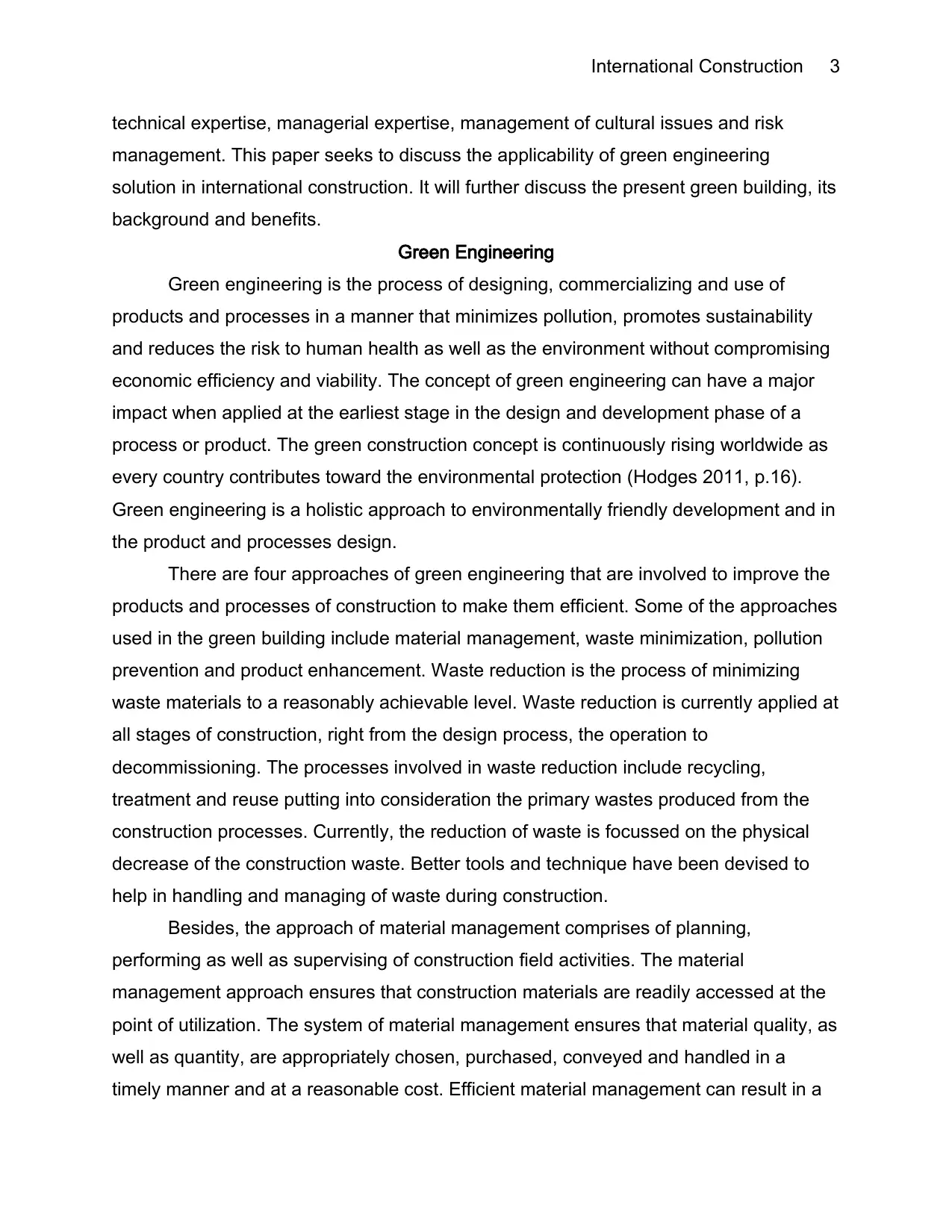
International Construction 3
technical expertise, managerial expertise, management of cultural issues and risk
management. This paper seeks to discuss the applicability of green engineering
solution in international construction. It will further discuss the present green building, its
background and benefits.
Green Engineering
Green engineering is the process of designing, commercializing and use of
products and processes in a manner that minimizes pollution, promotes sustainability
and reduces the risk to human health as well as the environment without compromising
economic efficiency and viability. The concept of green engineering can have a major
impact when applied at the earliest stage in the design and development phase of a
process or product. The green construction concept is continuously rising worldwide as
every country contributes toward the environmental protection (Hodges 2011, p.16).
Green engineering is a holistic approach to environmentally friendly development and in
the product and processes design.
There are four approaches of green engineering that are involved to improve the
products and processes of construction to make them efficient. Some of the approaches
used in the green building include material management, waste minimization, pollution
prevention and product enhancement. Waste reduction is the process of minimizing
waste materials to a reasonably achievable level. Waste reduction is currently applied at
all stages of construction, right from the design process, the operation to
decommissioning. The processes involved in waste reduction include recycling,
treatment and reuse putting into consideration the primary wastes produced from the
construction processes. Currently, the reduction of waste is focussed on the physical
decrease of the construction waste. Better tools and technique have been devised to
help in handling and managing of waste during construction.
Besides, the approach of material management comprises of planning,
performing as well as supervising of construction field activities. The material
management approach ensures that construction materials are readily accessed at the
point of utilization. The system of material management ensures that material quality, as
well as quantity, are appropriately chosen, purchased, conveyed and handled in a
timely manner and at a reasonable cost. Efficient material management can result in a
technical expertise, managerial expertise, management of cultural issues and risk
management. This paper seeks to discuss the applicability of green engineering
solution in international construction. It will further discuss the present green building, its
background and benefits.
Green Engineering
Green engineering is the process of designing, commercializing and use of
products and processes in a manner that minimizes pollution, promotes sustainability
and reduces the risk to human health as well as the environment without compromising
economic efficiency and viability. The concept of green engineering can have a major
impact when applied at the earliest stage in the design and development phase of a
process or product. The green construction concept is continuously rising worldwide as
every country contributes toward the environmental protection (Hodges 2011, p.16).
Green engineering is a holistic approach to environmentally friendly development and in
the product and processes design.
There are four approaches of green engineering that are involved to improve the
products and processes of construction to make them efficient. Some of the approaches
used in the green building include material management, waste minimization, pollution
prevention and product enhancement. Waste reduction is the process of minimizing
waste materials to a reasonably achievable level. Waste reduction is currently applied at
all stages of construction, right from the design process, the operation to
decommissioning. The processes involved in waste reduction include recycling,
treatment and reuse putting into consideration the primary wastes produced from the
construction processes. Currently, the reduction of waste is focussed on the physical
decrease of the construction waste. Better tools and technique have been devised to
help in handling and managing of waste during construction.
Besides, the approach of material management comprises of planning,
performing as well as supervising of construction field activities. The material
management approach ensures that construction materials are readily accessed at the
point of utilization. The system of material management ensures that material quality, as
well as quantity, are appropriately chosen, purchased, conveyed and handled in a
timely manner and at a reasonable cost. Efficient material management can result in a
⊘ This is a preview!⊘
Do you want full access?
Subscribe today to unlock all pages.

Trusted by 1+ million students worldwide
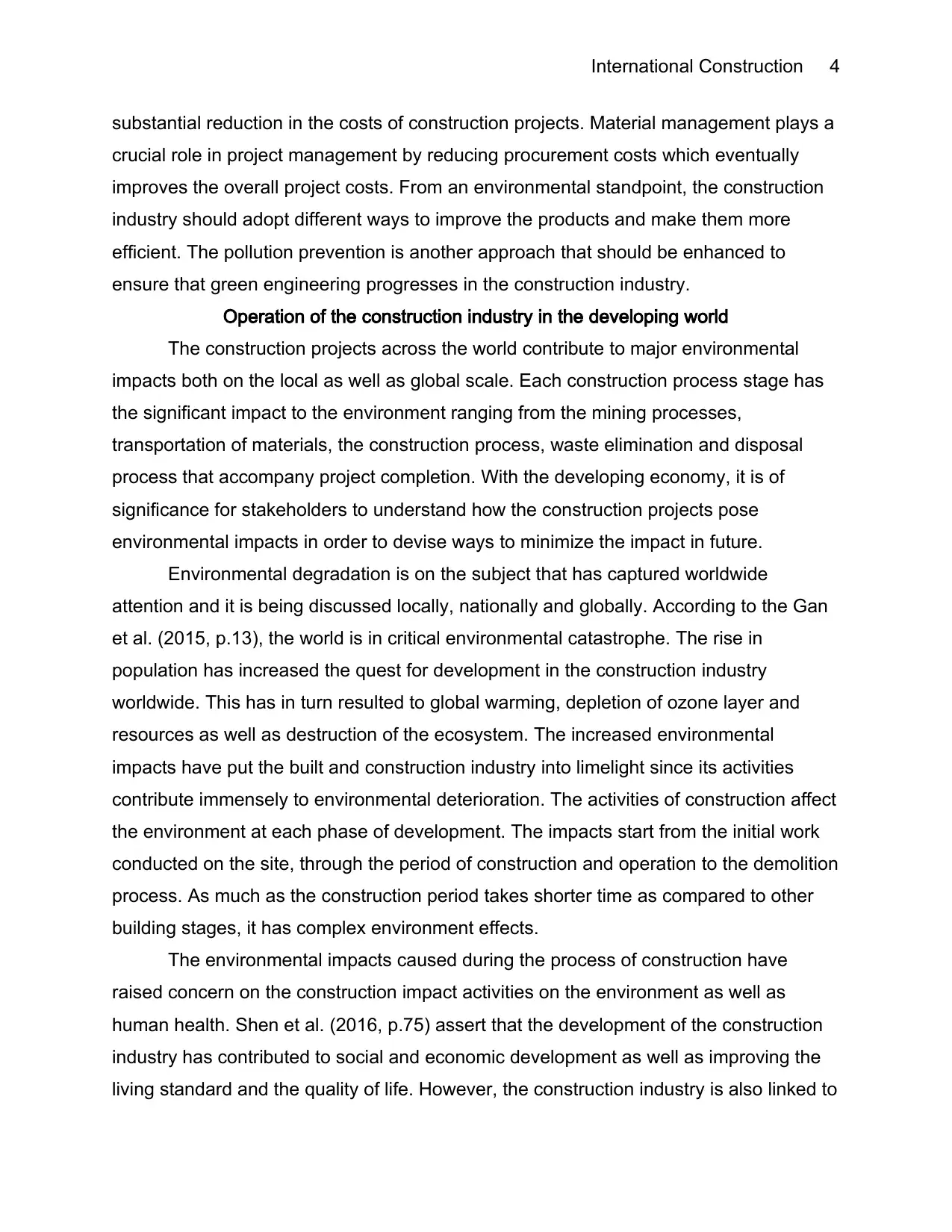
International Construction 4
substantial reduction in the costs of construction projects. Material management plays a
crucial role in project management by reducing procurement costs which eventually
improves the overall project costs. From an environmental standpoint, the construction
industry should adopt different ways to improve the products and make them more
efficient. The pollution prevention is another approach that should be enhanced to
ensure that green engineering progresses in the construction industry.
Operation of the construction industry in the developing world
The construction projects across the world contribute to major environmental
impacts both on the local as well as global scale. Each construction process stage has
the significant impact to the environment ranging from the mining processes,
transportation of materials, the construction process, waste elimination and disposal
process that accompany project completion. With the developing economy, it is of
significance for stakeholders to understand how the construction projects pose
environmental impacts in order to devise ways to minimize the impact in future.
Environmental degradation is on the subject that has captured worldwide
attention and it is being discussed locally, nationally and globally. According to the Gan
et al. (2015, p.13), the world is in critical environmental catastrophe. The rise in
population has increased the quest for development in the construction industry
worldwide. This has in turn resulted to global warming, depletion of ozone layer and
resources as well as destruction of the ecosystem. The increased environmental
impacts have put the built and construction industry into limelight since its activities
contribute immensely to environmental deterioration. The activities of construction affect
the environment at each phase of development. The impacts start from the initial work
conducted on the site, through the period of construction and operation to the demolition
process. As much as the construction period takes shorter time as compared to other
building stages, it has complex environment effects.
The environmental impacts caused during the process of construction have
raised concern on the construction impact activities on the environment as well as
human health. Shen et al. (2016, p.75) assert that the development of the construction
industry has contributed to social and economic development as well as improving the
living standard and the quality of life. However, the construction industry is also linked to
substantial reduction in the costs of construction projects. Material management plays a
crucial role in project management by reducing procurement costs which eventually
improves the overall project costs. From an environmental standpoint, the construction
industry should adopt different ways to improve the products and make them more
efficient. The pollution prevention is another approach that should be enhanced to
ensure that green engineering progresses in the construction industry.
Operation of the construction industry in the developing world
The construction projects across the world contribute to major environmental
impacts both on the local as well as global scale. Each construction process stage has
the significant impact to the environment ranging from the mining processes,
transportation of materials, the construction process, waste elimination and disposal
process that accompany project completion. With the developing economy, it is of
significance for stakeholders to understand how the construction projects pose
environmental impacts in order to devise ways to minimize the impact in future.
Environmental degradation is on the subject that has captured worldwide
attention and it is being discussed locally, nationally and globally. According to the Gan
et al. (2015, p.13), the world is in critical environmental catastrophe. The rise in
population has increased the quest for development in the construction industry
worldwide. This has in turn resulted to global warming, depletion of ozone layer and
resources as well as destruction of the ecosystem. The increased environmental
impacts have put the built and construction industry into limelight since its activities
contribute immensely to environmental deterioration. The activities of construction affect
the environment at each phase of development. The impacts start from the initial work
conducted on the site, through the period of construction and operation to the demolition
process. As much as the construction period takes shorter time as compared to other
building stages, it has complex environment effects.
The environmental impacts caused during the process of construction have
raised concern on the construction impact activities on the environment as well as
human health. Shen et al. (2016, p.75) assert that the development of the construction
industry has contributed to social and economic development as well as improving the
living standard and the quality of life. However, the construction industry is also linked to
Paraphrase This Document
Need a fresh take? Get an instant paraphrase of this document with our AI Paraphraser

International Construction 5
environmental deterioration. This situation is experienced in Ghana and is not different
from the developing countries. The developing countries have mainly focused on the
growth of the economy and the quality of people’s life forgetting the environmental
protection aspect. According to the Ghana Statistical Service, the construction industry
accounts for 19 per cent to the Ghana economy (Olanrewaju 2011, p.46). It is the
second largest contributor to the Ghanaian economy but its negative contribution to the
environment is completely neglected. The construction activities range from the erection
of hospitals, houses, offices and factories to civil engineering works such as bridges and
roads. The development of construction activities in the developing countries is exerting
pressure on global natural resources. The unsustainable design and processes of
construction are degrading the environment.
Additionally, the construction projects emit methane, carbon dioxide and other
waste products that pollute the air and are believed to accelerate the global climate
change. The operation of heavy machinery in the mining projects to extract raw
materials for construction projects use has posed a harmful effect on the environment.
On a worldwide scale, the cement industries produce approximately 5 per cent of global
carbon dioxide emissions. The fossil fuels that are used to extract and transport
minerals, process them and even power machines in the construction sites emit carbon
dioxide.
The projects of the project also have a significant effect on the environment as
well as nature. In the construction sites, there are numerous sources of water pollution
such as paints, fossil fuels and toxic chemicals. The little chemical spills leach in the
ground and enter water ways contaminating the water and harm the aquatic life. In the
developing world, there exist less stringent requirements in the disposal of harmful
waste products which consequently result in environmental damage that occur after a
construction project. The project like the Dakota Access Pipeline has received a lot of
criticism due to the environmental impact they cause in areas they pass. The
transportation of fossil fuels over a long distance result to oil spills that seem undetected
for long periods which destroy wild lands that were previously undisturbed.
environmental deterioration. This situation is experienced in Ghana and is not different
from the developing countries. The developing countries have mainly focused on the
growth of the economy and the quality of people’s life forgetting the environmental
protection aspect. According to the Ghana Statistical Service, the construction industry
accounts for 19 per cent to the Ghana economy (Olanrewaju 2011, p.46). It is the
second largest contributor to the Ghanaian economy but its negative contribution to the
environment is completely neglected. The construction activities range from the erection
of hospitals, houses, offices and factories to civil engineering works such as bridges and
roads. The development of construction activities in the developing countries is exerting
pressure on global natural resources. The unsustainable design and processes of
construction are degrading the environment.
Additionally, the construction projects emit methane, carbon dioxide and other
waste products that pollute the air and are believed to accelerate the global climate
change. The operation of heavy machinery in the mining projects to extract raw
materials for construction projects use has posed a harmful effect on the environment.
On a worldwide scale, the cement industries produce approximately 5 per cent of global
carbon dioxide emissions. The fossil fuels that are used to extract and transport
minerals, process them and even power machines in the construction sites emit carbon
dioxide.
The projects of the project also have a significant effect on the environment as
well as nature. In the construction sites, there are numerous sources of water pollution
such as paints, fossil fuels and toxic chemicals. The little chemical spills leach in the
ground and enter water ways contaminating the water and harm the aquatic life. In the
developing world, there exist less stringent requirements in the disposal of harmful
waste products which consequently result in environmental damage that occur after a
construction project. The project like the Dakota Access Pipeline has received a lot of
criticism due to the environmental impact they cause in areas they pass. The
transportation of fossil fuels over a long distance result to oil spills that seem undetected
for long periods which destroy wild lands that were previously undisturbed.

International Construction 6
The contribution of Basic Approaches in Green Engineering
The depletion of non-renewable resources and the increasing population is
posing numerous challenges to the world. Therefore, green engineering is one of the
technical approaches that are essential in addressing these issues by utilizing advanced
engineering design and analysis in the construction industry. The extent of green
engineering relies upon personal discipline and perspective. Green engineering is
widely defined as the reduction of environmental impacts across all phases of
construction. It is of significance to recognize that green engineering is the only
appropriate approach to address the sustainability issue in construction projects. The
world is facing significant challenges as a result of the increased population and
consumption leading to depletion of non-renewable fossil fuels and other raw materials.
The approach revolves around material management.
Material management
Material management is a dynamic and complex process that involves people,
technologies, organizations and the processes that manage quantification, source
planning, purchasing, and supplier quality as well supplier quality assurance and quality
control. The material management approach in green engineering is also associated
with expediting, logistics, transportation and the control of material across the
construction project life cycle (Sood et al.2011, p.84). The concept of green engineering
is interdisciplinary which can be applied in the construction projects. Since most
construction projects require materials in the design of construction projects, engineers
ought to design the material that not only meets the design requirements but also
consider the societal, environmental and health impacts in the construction process.
The product life cycle is a key idea for Green Engineering materials
considerations. The product lifecycle comprises considerable inputs and output needed
starting from extraction, manufacturing, utilization, lastly to disposal. The raw materials
are extracted from the earth to produce products result in material depletion, ecosystem
disturbance, and energy utilization (McManus 2012, p.31). The raw materials are then
fabricated to change them into useful materials that can be used for the desired
purpose.
The contribution of Basic Approaches in Green Engineering
The depletion of non-renewable resources and the increasing population is
posing numerous challenges to the world. Therefore, green engineering is one of the
technical approaches that are essential in addressing these issues by utilizing advanced
engineering design and analysis in the construction industry. The extent of green
engineering relies upon personal discipline and perspective. Green engineering is
widely defined as the reduction of environmental impacts across all phases of
construction. It is of significance to recognize that green engineering is the only
appropriate approach to address the sustainability issue in construction projects. The
world is facing significant challenges as a result of the increased population and
consumption leading to depletion of non-renewable fossil fuels and other raw materials.
The approach revolves around material management.
Material management
Material management is a dynamic and complex process that involves people,
technologies, organizations and the processes that manage quantification, source
planning, purchasing, and supplier quality as well supplier quality assurance and quality
control. The material management approach in green engineering is also associated
with expediting, logistics, transportation and the control of material across the
construction project life cycle (Sood et al.2011, p.84). The concept of green engineering
is interdisciplinary which can be applied in the construction projects. Since most
construction projects require materials in the design of construction projects, engineers
ought to design the material that not only meets the design requirements but also
consider the societal, environmental and health impacts in the construction process.
The product life cycle is a key idea for Green Engineering materials
considerations. The product lifecycle comprises considerable inputs and output needed
starting from extraction, manufacturing, utilization, lastly to disposal. The raw materials
are extracted from the earth to produce products result in material depletion, ecosystem
disturbance, and energy utilization (McManus 2012, p.31). The raw materials are then
fabricated to change them into useful materials that can be used for the desired
purpose.
⊘ This is a preview!⊘
Do you want full access?
Subscribe today to unlock all pages.

Trusted by 1+ million students worldwide
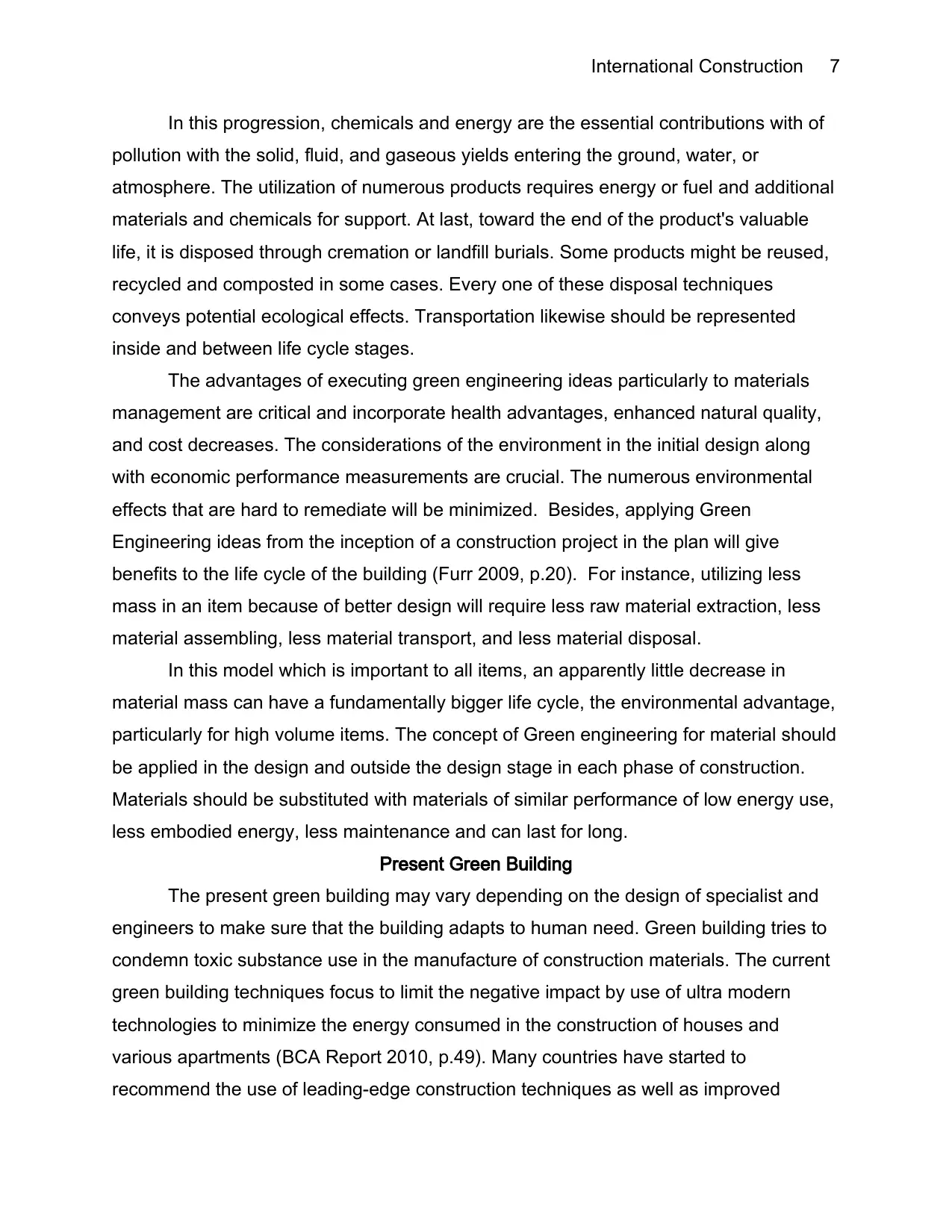
International Construction 7
In this progression, chemicals and energy are the essential contributions with of
pollution with the solid, fluid, and gaseous yields entering the ground, water, or
atmosphere. The utilization of numerous products requires energy or fuel and additional
materials and chemicals for support. At last, toward the end of the product's valuable
life, it is disposed through cremation or landfill burials. Some products might be reused,
recycled and composted in some cases. Every one of these disposal techniques
conveys potential ecological effects. Transportation likewise should be represented
inside and between life cycle stages.
The advantages of executing green engineering ideas particularly to materials
management are critical and incorporate health advantages, enhanced natural quality,
and cost decreases. The considerations of the environment in the initial design along
with economic performance measurements are crucial. The numerous environmental
effects that are hard to remediate will be minimized. Besides, applying Green
Engineering ideas from the inception of a construction project in the plan will give
benefits to the life cycle of the building (Furr 2009, p.20). For instance, utilizing less
mass in an item because of better design will require less raw material extraction, less
material assembling, less material transport, and less material disposal.
In this model which is important to all items, an apparently little decrease in
material mass can have a fundamentally bigger life cycle, the environmental advantage,
particularly for high volume items. The concept of Green engineering for material should
be applied in the design and outside the design stage in each phase of construction.
Materials should be substituted with materials of similar performance of low energy use,
less embodied energy, less maintenance and can last for long.
Present Green Building
The present green building may vary depending on the design of specialist and
engineers to make sure that the building adapts to human need. Green building tries to
condemn toxic substance use in the manufacture of construction materials. The current
green building techniques focus to limit the negative impact by use of ultra modern
technologies to minimize the energy consumed in the construction of houses and
various apartments (BCA Report 2010, p.49). Many countries have started to
recommend the use of leading-edge construction techniques as well as improved
In this progression, chemicals and energy are the essential contributions with of
pollution with the solid, fluid, and gaseous yields entering the ground, water, or
atmosphere. The utilization of numerous products requires energy or fuel and additional
materials and chemicals for support. At last, toward the end of the product's valuable
life, it is disposed through cremation or landfill burials. Some products might be reused,
recycled and composted in some cases. Every one of these disposal techniques
conveys potential ecological effects. Transportation likewise should be represented
inside and between life cycle stages.
The advantages of executing green engineering ideas particularly to materials
management are critical and incorporate health advantages, enhanced natural quality,
and cost decreases. The considerations of the environment in the initial design along
with economic performance measurements are crucial. The numerous environmental
effects that are hard to remediate will be minimized. Besides, applying Green
Engineering ideas from the inception of a construction project in the plan will give
benefits to the life cycle of the building (Furr 2009, p.20). For instance, utilizing less
mass in an item because of better design will require less raw material extraction, less
material assembling, less material transport, and less material disposal.
In this model which is important to all items, an apparently little decrease in
material mass can have a fundamentally bigger life cycle, the environmental advantage,
particularly for high volume items. The concept of Green engineering for material should
be applied in the design and outside the design stage in each phase of construction.
Materials should be substituted with materials of similar performance of low energy use,
less embodied energy, less maintenance and can last for long.
Present Green Building
The present green building may vary depending on the design of specialist and
engineers to make sure that the building adapts to human need. Green building tries to
condemn toxic substance use in the manufacture of construction materials. The current
green building techniques focus to limit the negative impact by use of ultra modern
technologies to minimize the energy consumed in the construction of houses and
various apartments (BCA Report 2010, p.49). Many countries have started to
recommend the use of leading-edge construction techniques as well as improved
Paraphrase This Document
Need a fresh take? Get an instant paraphrase of this document with our AI Paraphraser
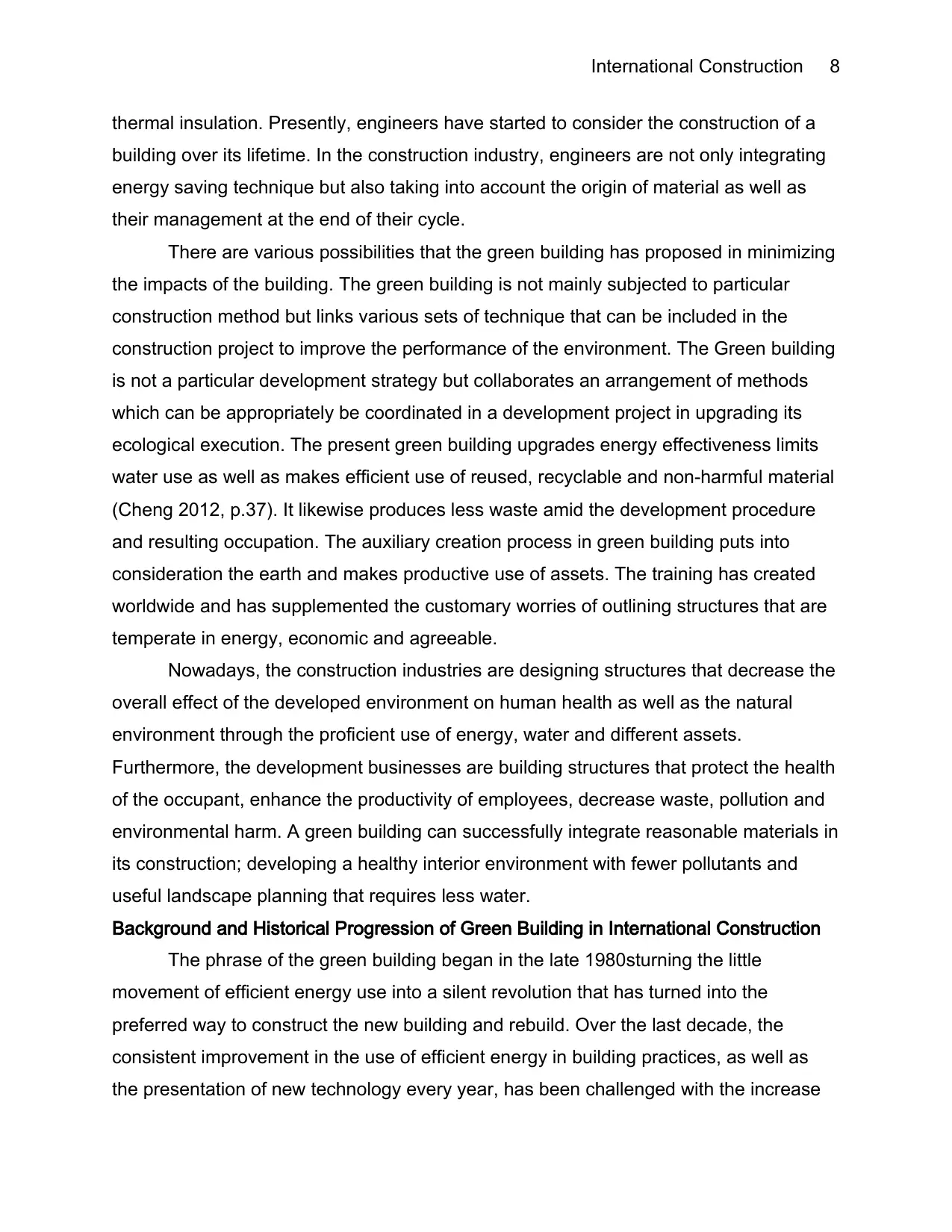
International Construction 8
thermal insulation. Presently, engineers have started to consider the construction of a
building over its lifetime. In the construction industry, engineers are not only integrating
energy saving technique but also taking into account the origin of material as well as
their management at the end of their cycle.
There are various possibilities that the green building has proposed in minimizing
the impacts of the building. The green building is not mainly subjected to particular
construction method but links various sets of technique that can be included in the
construction project to improve the performance of the environment. The Green building
is not a particular development strategy but collaborates an arrangement of methods
which can be appropriately be coordinated in a development project in upgrading its
ecological execution. The present green building upgrades energy effectiveness limits
water use as well as makes efficient use of reused, recyclable and non-harmful material
(Cheng 2012, p.37). It likewise produces less waste amid the development procedure
and resulting occupation. The auxiliary creation process in green building puts into
consideration the earth and makes productive use of assets. The training has created
worldwide and has supplemented the customary worries of outlining structures that are
temperate in energy, economic and agreeable.
Nowadays, the construction industries are designing structures that decrease the
overall effect of the developed environment on human health as well as the natural
environment through the proficient use of energy, water and different assets.
Furthermore, the development businesses are building structures that protect the health
of the occupant, enhance the productivity of employees, decrease waste, pollution and
environmental harm. A green building can successfully integrate reasonable materials in
its construction; developing a healthy interior environment with fewer pollutants and
useful landscape planning that requires less water.
Background and Historical Progression of Green Building in International Construction
The phrase of the green building began in the late 1980sturning the little
movement of efficient energy use into a silent revolution that has turned into the
preferred way to construct the new building and rebuild. Over the last decade, the
consistent improvement in the use of efficient energy in building practices, as well as
the presentation of new technology every year, has been challenged with the increase
thermal insulation. Presently, engineers have started to consider the construction of a
building over its lifetime. In the construction industry, engineers are not only integrating
energy saving technique but also taking into account the origin of material as well as
their management at the end of their cycle.
There are various possibilities that the green building has proposed in minimizing
the impacts of the building. The green building is not mainly subjected to particular
construction method but links various sets of technique that can be included in the
construction project to improve the performance of the environment. The Green building
is not a particular development strategy but collaborates an arrangement of methods
which can be appropriately be coordinated in a development project in upgrading its
ecological execution. The present green building upgrades energy effectiveness limits
water use as well as makes efficient use of reused, recyclable and non-harmful material
(Cheng 2012, p.37). It likewise produces less waste amid the development procedure
and resulting occupation. The auxiliary creation process in green building puts into
consideration the earth and makes productive use of assets. The training has created
worldwide and has supplemented the customary worries of outlining structures that are
temperate in energy, economic and agreeable.
Nowadays, the construction industries are designing structures that decrease the
overall effect of the developed environment on human health as well as the natural
environment through the proficient use of energy, water and different assets.
Furthermore, the development businesses are building structures that protect the health
of the occupant, enhance the productivity of employees, decrease waste, pollution and
environmental harm. A green building can successfully integrate reasonable materials in
its construction; developing a healthy interior environment with fewer pollutants and
useful landscape planning that requires less water.
Background and Historical Progression of Green Building in International Construction
The phrase of the green building began in the late 1980sturning the little
movement of efficient energy use into a silent revolution that has turned into the
preferred way to construct the new building and rebuild. Over the last decade, the
consistent improvement in the use of efficient energy in building practices, as well as
the presentation of new technology every year, has been challenged with the increase

International Construction 9
in public awareness on numerous aspects of Green Building Technology. In 2007, the
National Association of Home Builders (NAHB) and the International Code Council
(ICC) collaborated to come up with the much needed and worldwide known standard
green building meaning. The subsequent ICC 700 National Green Building Standard
endorsement was from the American National Standards Institute (ANSI). This green
standard characterizes the level of green building or multi-family as well as single
homes and site advancement projects while taking into account the adaptability required
for regionally suitable practices.
The National Green Building standard, the US Green Building Councils,
Leadership in Energy and Environmental plan and the Federal Government's Energy
Star program are the broad certified program on the green building issue (Beeken et al.
2012, p.13). Thousands of homes and structures built dependent on these standards
each year. The ICC oversees and improves the national residual construction regulation
(IRC) that all States embrace and utilize. This has enhanced the energy codes over the
most recent couple of years to reflect the least standard in energy efficiency that is
drawing nearer to the generally acknowledged National Green Building standard.
For many countries, electricity represents the majority of the overall energy usage and
carbon emissions.
In China, due to the massive amount of energy required for the product market,
citizens have become aware of environmental issues, such as the health hazards of
conventional food and waste management techniques used by companies. According to
Anderson et al.2017, p.37, as the world uses more of its resources, enhancing energy
efficiency is viewed as a standout amongst the most essential alternatives for
decreasing the greenhouse gases emanations and the reliance of nations on energy
imports (Anderson et al. 2009, p.37). There are many Chinese enterprises that are
involved in high energy consumption and heavy pollution markets that have neglected
environmental protection. However, the government is regulating these companies with
laws to address pollution control and natural resource conservation (Carbon 2015, p.
74). For instance, the government has been promoting policies toward alternative
energies, particularly on using smart grids which make the overall power grid cleaner
and more efficient. These smart grids are more environmentally and user-friendly than
in public awareness on numerous aspects of Green Building Technology. In 2007, the
National Association of Home Builders (NAHB) and the International Code Council
(ICC) collaborated to come up with the much needed and worldwide known standard
green building meaning. The subsequent ICC 700 National Green Building Standard
endorsement was from the American National Standards Institute (ANSI). This green
standard characterizes the level of green building or multi-family as well as single
homes and site advancement projects while taking into account the adaptability required
for regionally suitable practices.
The National Green Building standard, the US Green Building Councils,
Leadership in Energy and Environmental plan and the Federal Government's Energy
Star program are the broad certified program on the green building issue (Beeken et al.
2012, p.13). Thousands of homes and structures built dependent on these standards
each year. The ICC oversees and improves the national residual construction regulation
(IRC) that all States embrace and utilize. This has enhanced the energy codes over the
most recent couple of years to reflect the least standard in energy efficiency that is
drawing nearer to the generally acknowledged National Green Building standard.
For many countries, electricity represents the majority of the overall energy usage and
carbon emissions.
In China, due to the massive amount of energy required for the product market,
citizens have become aware of environmental issues, such as the health hazards of
conventional food and waste management techniques used by companies. According to
Anderson et al.2017, p.37, as the world uses more of its resources, enhancing energy
efficiency is viewed as a standout amongst the most essential alternatives for
decreasing the greenhouse gases emanations and the reliance of nations on energy
imports (Anderson et al. 2009, p.37). There are many Chinese enterprises that are
involved in high energy consumption and heavy pollution markets that have neglected
environmental protection. However, the government is regulating these companies with
laws to address pollution control and natural resource conservation (Carbon 2015, p.
74). For instance, the government has been promoting policies toward alternative
energies, particularly on using smart grids which make the overall power grid cleaner
and more efficient. These smart grids are more environmentally and user-friendly than
⊘ This is a preview!⊘
Do you want full access?
Subscribe today to unlock all pages.

Trusted by 1+ million students worldwide
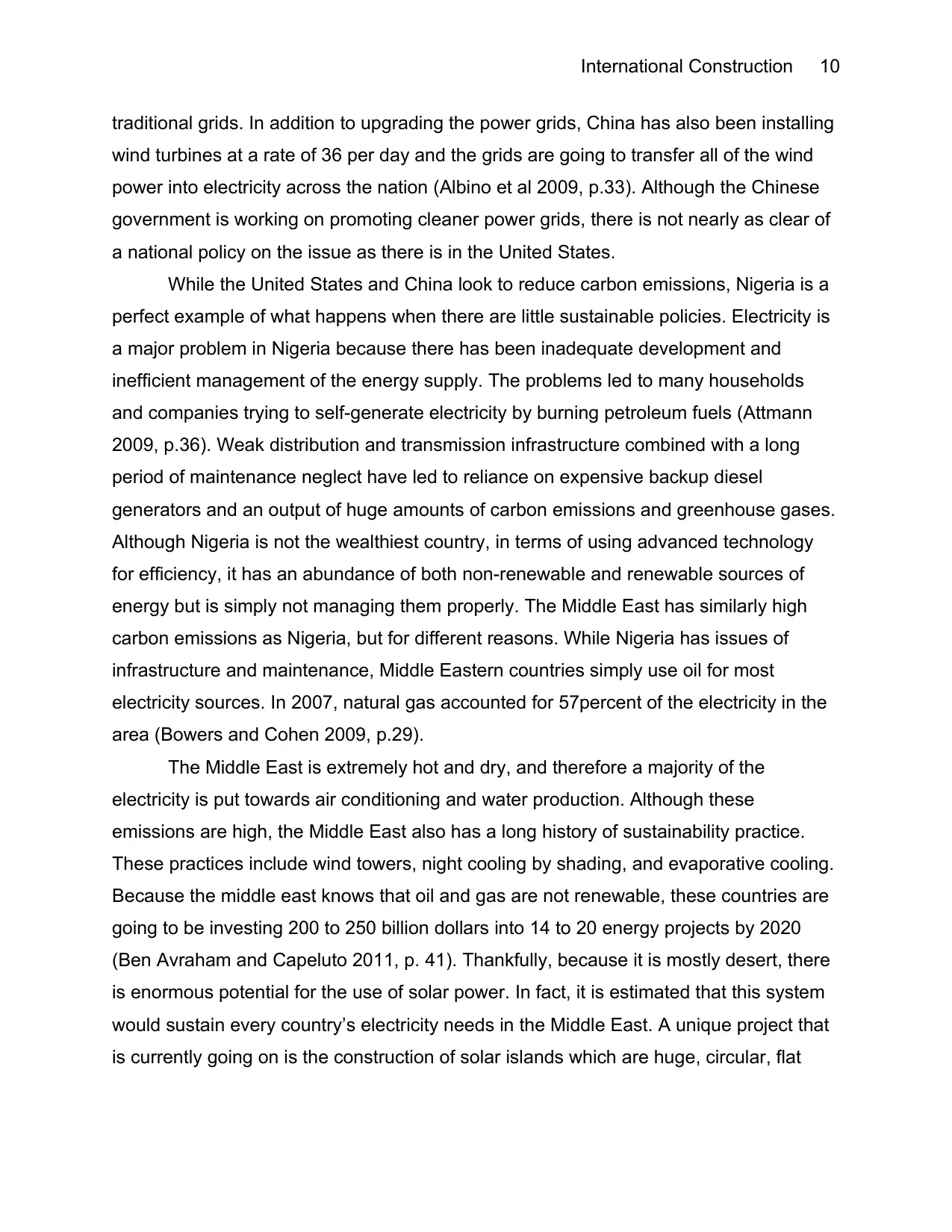
International Construction 10
traditional grids. In addition to upgrading the power grids, China has also been installing
wind turbines at a rate of 36 per day and the grids are going to transfer all of the wind
power into electricity across the nation (Albino et al 2009, p.33). Although the Chinese
government is working on promoting cleaner power grids, there is not nearly as clear of
a national policy on the issue as there is in the United States.
While the United States and China look to reduce carbon emissions, Nigeria is a
perfect example of what happens when there are little sustainable policies. Electricity is
a major problem in Nigeria because there has been inadequate development and
inefficient management of the energy supply. The problems led to many households
and companies trying to self-generate electricity by burning petroleum fuels (Attmann
2009, p.36). Weak distribution and transmission infrastructure combined with a long
period of maintenance neglect have led to reliance on expensive backup diesel
generators and an output of huge amounts of carbon emissions and greenhouse gases.
Although Nigeria is not the wealthiest country, in terms of using advanced technology
for efficiency, it has an abundance of both non-renewable and renewable sources of
energy but is simply not managing them properly. The Middle East has similarly high
carbon emissions as Nigeria, but for different reasons. While Nigeria has issues of
infrastructure and maintenance, Middle Eastern countries simply use oil for most
electricity sources. In 2007, natural gas accounted for 57percent of the electricity in the
area (Bowers and Cohen 2009, p.29).
The Middle East is extremely hot and dry, and therefore a majority of the
electricity is put towards air conditioning and water production. Although these
emissions are high, the Middle East also has a long history of sustainability practice.
These practices include wind towers, night cooling by shading, and evaporative cooling.
Because the middle east knows that oil and gas are not renewable, these countries are
going to be investing 200 to 250 billion dollars into 14 to 20 energy projects by 2020
(Ben Avraham and Capeluto 2011, p. 41). Thankfully, because it is mostly desert, there
is enormous potential for the use of solar power. In fact, it is estimated that this system
would sustain every country’s electricity needs in the Middle East. A unique project that
is currently going on is the construction of solar islands which are huge, circular, flat
traditional grids. In addition to upgrading the power grids, China has also been installing
wind turbines at a rate of 36 per day and the grids are going to transfer all of the wind
power into electricity across the nation (Albino et al 2009, p.33). Although the Chinese
government is working on promoting cleaner power grids, there is not nearly as clear of
a national policy on the issue as there is in the United States.
While the United States and China look to reduce carbon emissions, Nigeria is a
perfect example of what happens when there are little sustainable policies. Electricity is
a major problem in Nigeria because there has been inadequate development and
inefficient management of the energy supply. The problems led to many households
and companies trying to self-generate electricity by burning petroleum fuels (Attmann
2009, p.36). Weak distribution and transmission infrastructure combined with a long
period of maintenance neglect have led to reliance on expensive backup diesel
generators and an output of huge amounts of carbon emissions and greenhouse gases.
Although Nigeria is not the wealthiest country, in terms of using advanced technology
for efficiency, it has an abundance of both non-renewable and renewable sources of
energy but is simply not managing them properly. The Middle East has similarly high
carbon emissions as Nigeria, but for different reasons. While Nigeria has issues of
infrastructure and maintenance, Middle Eastern countries simply use oil for most
electricity sources. In 2007, natural gas accounted for 57percent of the electricity in the
area (Bowers and Cohen 2009, p.29).
The Middle East is extremely hot and dry, and therefore a majority of the
electricity is put towards air conditioning and water production. Although these
emissions are high, the Middle East also has a long history of sustainability practice.
These practices include wind towers, night cooling by shading, and evaporative cooling.
Because the middle east knows that oil and gas are not renewable, these countries are
going to be investing 200 to 250 billion dollars into 14 to 20 energy projects by 2020
(Ben Avraham and Capeluto 2011, p. 41). Thankfully, because it is mostly desert, there
is enormous potential for the use of solar power. In fact, it is estimated that this system
would sustain every country’s electricity needs in the Middle East. A unique project that
is currently going on is the construction of solar islands which are huge, circular, flat
Paraphrase This Document
Need a fresh take? Get an instant paraphrase of this document with our AI Paraphraser
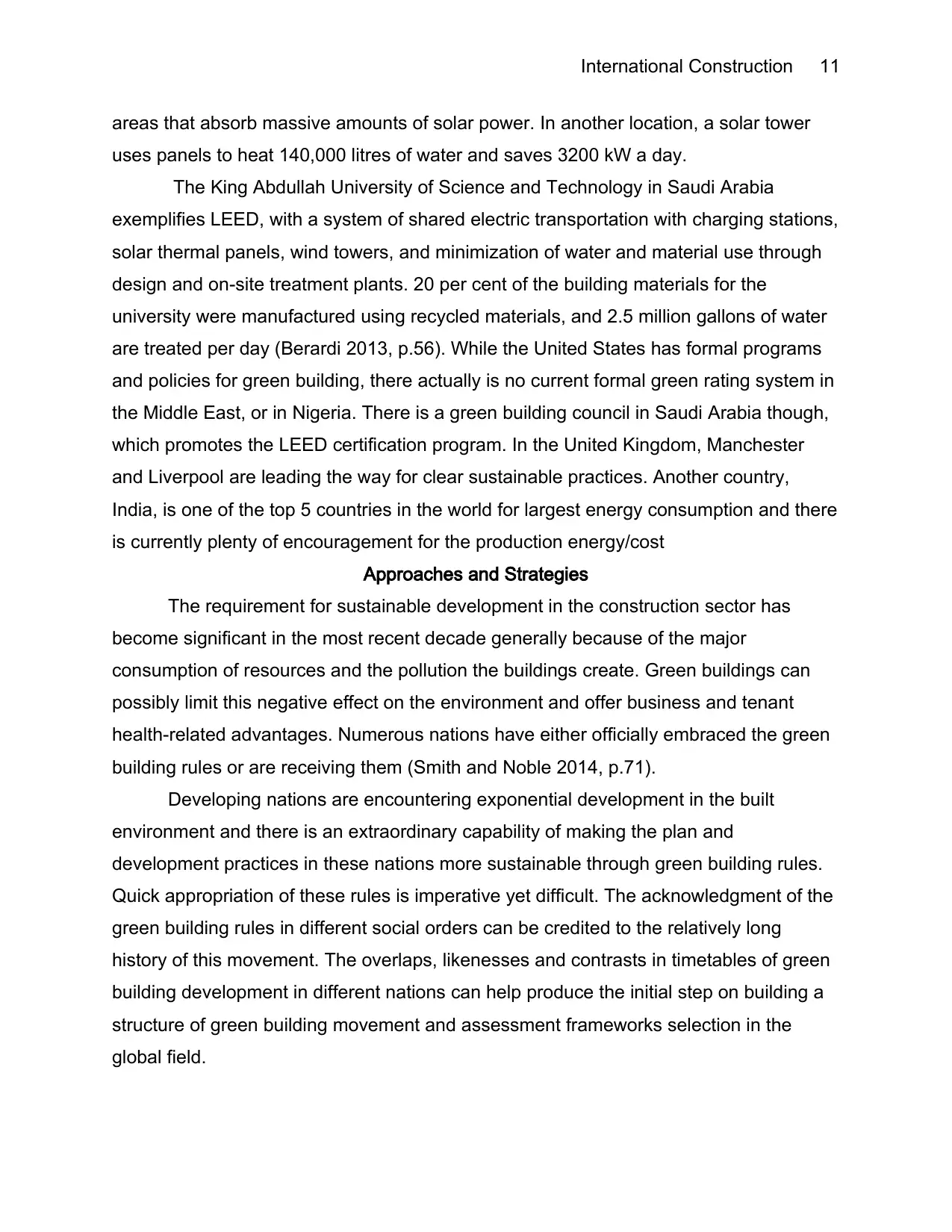
International Construction 11
areas that absorb massive amounts of solar power. In another location, a solar tower
uses panels to heat 140,000 litres of water and saves 3200 kW a day.
The King Abdullah University of Science and Technology in Saudi Arabia
exemplifies LEED, with a system of shared electric transportation with charging stations,
solar thermal panels, wind towers, and minimization of water and material use through
design and on-site treatment plants. 20 per cent of the building materials for the
university were manufactured using recycled materials, and 2.5 million gallons of water
are treated per day (Berardi 2013, p.56). While the United States has formal programs
and policies for green building, there actually is no current formal green rating system in
the Middle East, or in Nigeria. There is a green building council in Saudi Arabia though,
which promotes the LEED certification program. In the United Kingdom, Manchester
and Liverpool are leading the way for clear sustainable practices. Another country,
India, is one of the top 5 countries in the world for largest energy consumption and there
is currently plenty of encouragement for the production energy/cost
Approaches and Strategies
The requirement for sustainable development in the construction sector has
become significant in the most recent decade generally because of the major
consumption of resources and the pollution the buildings create. Green buildings can
possibly limit this negative effect on the environment and offer business and tenant
health-related advantages. Numerous nations have either officially embraced the green
building rules or are receiving them (Smith and Noble 2014, p.71).
Developing nations are encountering exponential development in the built
environment and there is an extraordinary capability of making the plan and
development practices in these nations more sustainable through green building rules.
Quick appropriation of these rules is imperative yet difficult. The acknowledgment of the
green building rules in different social orders can be credited to the relatively long
history of this movement. The overlaps, likenesses and contrasts in timetables of green
building development in different nations can help produce the initial step on building a
structure of green building movement and assessment frameworks selection in the
global field.
areas that absorb massive amounts of solar power. In another location, a solar tower
uses panels to heat 140,000 litres of water and saves 3200 kW a day.
The King Abdullah University of Science and Technology in Saudi Arabia
exemplifies LEED, with a system of shared electric transportation with charging stations,
solar thermal panels, wind towers, and minimization of water and material use through
design and on-site treatment plants. 20 per cent of the building materials for the
university were manufactured using recycled materials, and 2.5 million gallons of water
are treated per day (Berardi 2013, p.56). While the United States has formal programs
and policies for green building, there actually is no current formal green rating system in
the Middle East, or in Nigeria. There is a green building council in Saudi Arabia though,
which promotes the LEED certification program. In the United Kingdom, Manchester
and Liverpool are leading the way for clear sustainable practices. Another country,
India, is one of the top 5 countries in the world for largest energy consumption and there
is currently plenty of encouragement for the production energy/cost
Approaches and Strategies
The requirement for sustainable development in the construction sector has
become significant in the most recent decade generally because of the major
consumption of resources and the pollution the buildings create. Green buildings can
possibly limit this negative effect on the environment and offer business and tenant
health-related advantages. Numerous nations have either officially embraced the green
building rules or are receiving them (Smith and Noble 2014, p.71).
Developing nations are encountering exponential development in the built
environment and there is an extraordinary capability of making the plan and
development practices in these nations more sustainable through green building rules.
Quick appropriation of these rules is imperative yet difficult. The acknowledgment of the
green building rules in different social orders can be credited to the relatively long
history of this movement. The overlaps, likenesses and contrasts in timetables of green
building development in different nations can help produce the initial step on building a
structure of green building movement and assessment frameworks selection in the
global field.
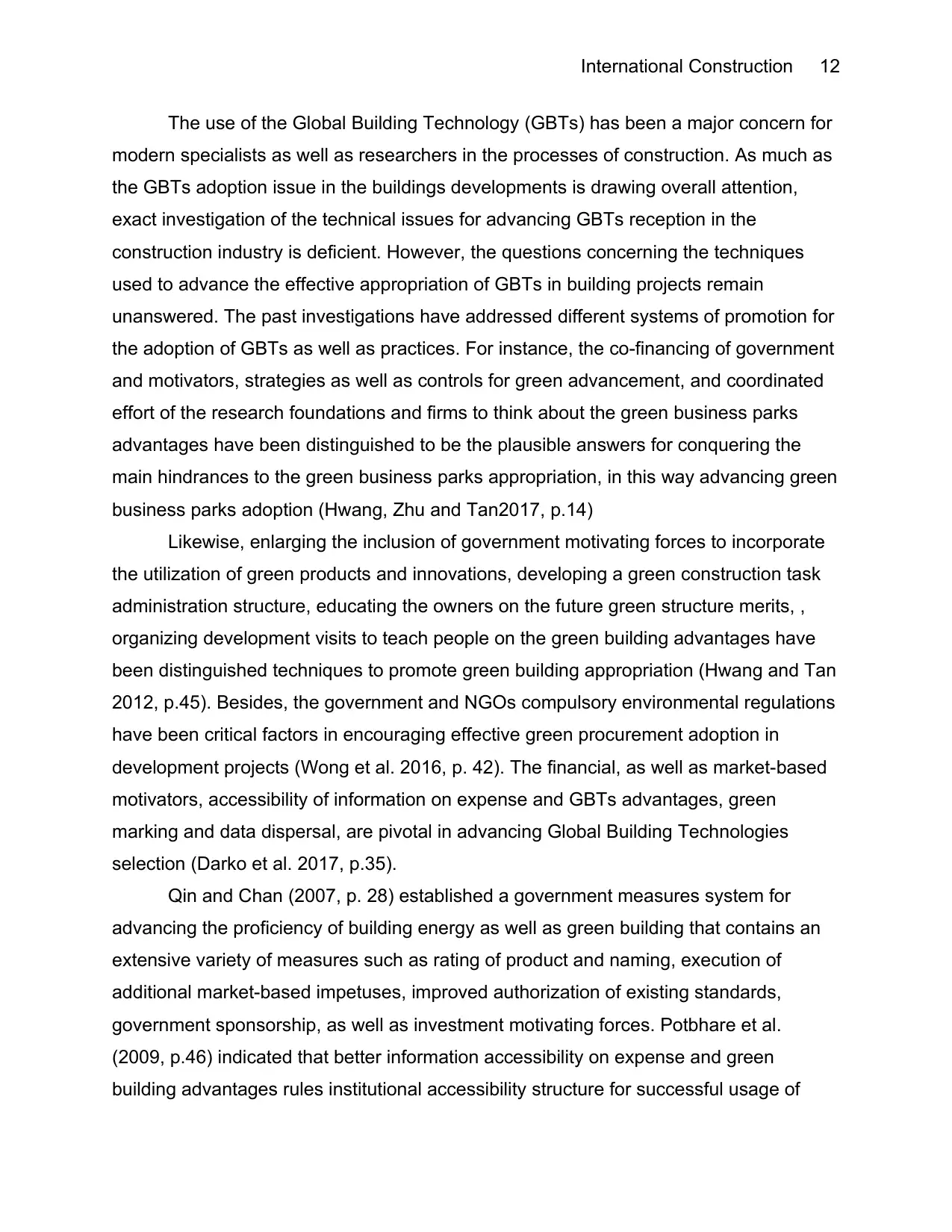
International Construction 12
The use of the Global Building Technology (GBTs) has been a major concern for
modern specialists as well as researchers in the processes of construction. As much as
the GBTs adoption issue in the buildings developments is drawing overall attention,
exact investigation of the technical issues for advancing GBTs reception in the
construction industry is deficient. However, the questions concerning the techniques
used to advance the effective appropriation of GBTs in building projects remain
unanswered. The past investigations have addressed different systems of promotion for
the adoption of GBTs as well as practices. For instance, the co-financing of government
and motivators, strategies as well as controls for green advancement, and coordinated
effort of the research foundations and firms to think about the green business parks
advantages have been distinguished to be the plausible answers for conquering the
main hindrances to the green business parks appropriation, in this way advancing green
business parks adoption (Hwang, Zhu and Tan2017, p.14)
Likewise, enlarging the inclusion of government motivating forces to incorporate
the utilization of green products and innovations, developing a green construction task
administration structure, educating the owners on the future green structure merits, ,
organizing development visits to teach people on the green building advantages have
been distinguished techniques to promote green building appropriation (Hwang and Tan
2012, p.45). Besides, the government and NGOs compulsory environmental regulations
have been critical factors in encouraging effective green procurement adoption in
development projects (Wong et al. 2016, p. 42). The financial, as well as market-based
motivators, accessibility of information on expense and GBTs advantages, green
marking and data dispersal, are pivotal in advancing Global Building Technologies
selection (Darko et al. 2017, p.35).
Qin and Chan (2007, p. 28) established a government measures system for
advancing the proficiency of building energy as well as green building that contains an
extensive variety of measures such as rating of product and naming, execution of
additional market-based impetuses, improved authorization of existing standards,
government sponsorship, as well as investment motivating forces. Potbhare et al.
(2009, p.46) indicated that better information accessibility on expense and green
building advantages rules institutional accessibility structure for successful usage of
The use of the Global Building Technology (GBTs) has been a major concern for
modern specialists as well as researchers in the processes of construction. As much as
the GBTs adoption issue in the buildings developments is drawing overall attention,
exact investigation of the technical issues for advancing GBTs reception in the
construction industry is deficient. However, the questions concerning the techniques
used to advance the effective appropriation of GBTs in building projects remain
unanswered. The past investigations have addressed different systems of promotion for
the adoption of GBTs as well as practices. For instance, the co-financing of government
and motivators, strategies as well as controls for green advancement, and coordinated
effort of the research foundations and firms to think about the green business parks
advantages have been distinguished to be the plausible answers for conquering the
main hindrances to the green business parks appropriation, in this way advancing green
business parks adoption (Hwang, Zhu and Tan2017, p.14)
Likewise, enlarging the inclusion of government motivating forces to incorporate
the utilization of green products and innovations, developing a green construction task
administration structure, educating the owners on the future green structure merits, ,
organizing development visits to teach people on the green building advantages have
been distinguished techniques to promote green building appropriation (Hwang and Tan
2012, p.45). Besides, the government and NGOs compulsory environmental regulations
have been critical factors in encouraging effective green procurement adoption in
development projects (Wong et al. 2016, p. 42). The financial, as well as market-based
motivators, accessibility of information on expense and GBTs advantages, green
marking and data dispersal, are pivotal in advancing Global Building Technologies
selection (Darko et al. 2017, p.35).
Qin and Chan (2007, p. 28) established a government measures system for
advancing the proficiency of building energy as well as green building that contains an
extensive variety of measures such as rating of product and naming, execution of
additional market-based impetuses, improved authorization of existing standards,
government sponsorship, as well as investment motivating forces. Potbhare et al.
(2009, p.46) indicated that better information accessibility on expense and green
building advantages rules institutional accessibility structure for successful usage of
⊘ This is a preview!⊘
Do you want full access?
Subscribe today to unlock all pages.

Trusted by 1+ million students worldwide
1 out of 18
Related Documents
Your All-in-One AI-Powered Toolkit for Academic Success.
+13062052269
info@desklib.com
Available 24*7 on WhatsApp / Email
![[object Object]](/_next/static/media/star-bottom.7253800d.svg)
Unlock your academic potential
Copyright © 2020–2025 A2Z Services. All Rights Reserved. Developed and managed by ZUCOL.





